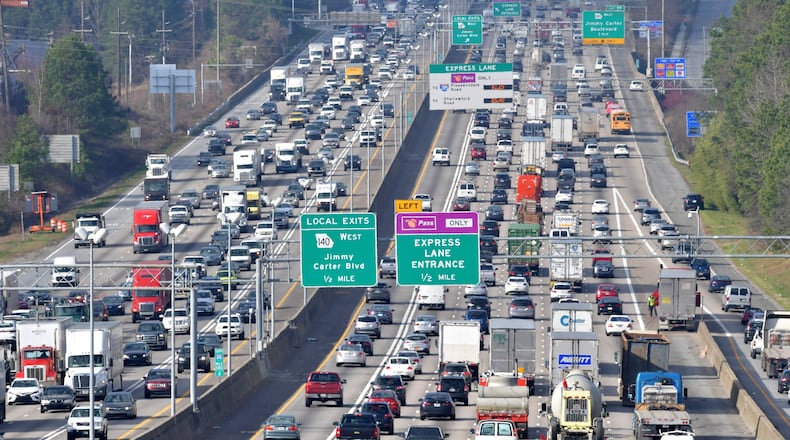For years state and local officials have tried to fix the traffic mess that is I-85 just north of the Perimeter.
New diverging-diamond interchanges helped, but they didn't solve the problem. Toll lanes helped, too, but they sometimes bog down amid rising traffic volumes. Voters last year rejected an effort to boost transit in the corridor.
Despite those and other efforts, I-85 outside the Perimeter remains clogged with up to 340,000 vehicles a day. Traffic jams stretch up to 11 miles. Rush hour — which lasts most of the morning — can ruin your day. And sometimes — such as last weekend, when a fiery truck crash near Jimmy Carter Boulevard shut down northbound traffic for hours — I-85 seems fundamentally broken.
The Georgia Department of Transportation and Gwinnett County are ready to try again. They’ve launched a study to address traffic and safety problems along I-85 from the Perimeter to I-985 in Gwinnett. And they’ve laid out a menu of potential fixes — including toll lanes and high-capacity transit — that could make a difference.
The renewed attention to I-85 follows GDOT's efforts to address congestion on other metro highways in recent years. The agency has built toll lanes on I-75 south and northwest of Atlanta. It's also planning toll lanes on the top half of the Perimeter and along Ga. 400. And it extended similar lanes along I-85 further out to the northeast.
But the section of I-85 outside the Perimeter remains a chokepoint, and traffic volumes are rising. The section of highway between Jimmy Carter Boulevard and Indian Trail Road added 24,000 vehicles a day on average from 2014 to 2018, GDOT statistics show. That’s up nearly 9%.
“The number of commuters, and the amount of freight that travels through, it’s crazy,” said Phil Peevy, the Atlanta branch chief in GDOT’s planning department.
Major changes likely won’t come soon. The study is expected to take at least three years. And implementing fixes could take many more.
In the meantime, GDOT and Gwinnett are asking residents for solutions at a series of meetings and through an online survey. At a meeting Tuesday night in Norcross, dozens of people offered ideas.
Former Snellville Mayor Jerry Oberholtzer, who attended the meeting and drives I-85 to work each day, said commuters are eager for relief. When asked what he hoped would come of the study, he summed up the desires of many in metro Atlanta: “Something done.”
A key stretch of highway
The I-85 study area stretches 18 miles through highly developed areas of Gwinnett and DeKalb counties. It includes 16 interchanges, five cities and a booming population of more than half a million.
It’s an area bustling with warehouses, manufacturers and businesses. But 45% of the trucks in the corridor are just passing through, according to GDOT.
It’s a recipe for congestion. At the height of morning rush hour, it takes an average of 40 minutes to travel the 18 miles — twice as long as when traffic is moving at 65 mph.
Michael Roberts of Norcross avoids I-85 when he commutes to Alpharetta. He said traffic is almost always bad.
“After 6 a.m., you basically can’t take 85 until 2 p.m., and then only for 30 minutes,” Roberts said.
GDOT and Gwinnett have taken steps to improve traffic on I-85 over the years. Among other things, the county built diverging-diamond interchanges at Jimmy Carter Boulevard and Pleasant Hill Road.
In 2011, GDOT converted HOV lanes along I-85 to toll lanes. And in 2018 it extended those lanes an additional 10 miles to Hamilton Mill Road. But as the region grows and traffic increases, even the toll lanes at times get bogged down.
Additional toll lanes are one recommendation that likely will get a close look. GDOT says they're better than building more "free" lanes, which tend to fill up shortly after they open.
By comparison, GDOT says it can "manage" traffic in the toll lanes. The tolls rise as traffic gets worse, discouraging some motorists from using them and keeping traffic moving. Studies show the toll lanes carry more vehicles per hour at rush hour than the free lanes because traffic in the free lanes is crawling.
“It’s just logical to me that would be one of potentially many improvements or alternatives,” GDOT spokesman Scott Higley said.
Other ideas
Another potential solution: public transportation. Gwinnett's transit plan calls for an extension of MARTA rail to Jimmy Carter Boulevard, as well as bus rapid transit — enhanced bus service with limited stops and features that mimic rail lines — along the I-85 corridor.
Gwinnett voters rejected a sales tax increase for transit expansion last March. But county officials may place a revised plan on the November ballot.
Roberts, the Norcross resident, would love to see more transit along I-85.
“The only reason there are so many people on 85 is there’s no other way to get around,” he said.
At Tuesday’s public meeting, residents weighed in on other ideas for improving traffic, including trucks-only lanes, more frontage roads, interchange improvements, widening roads that connect to I-85, carpooling, and more commuter and local buses. Some suggested routing traffic away from I-85 altogether.
“I hate the idea of another bypass around Atlanta,” said Dominic Perello of Norcross. “But that’s what we need.”
GDOT’s Peevy said the study likely will yield multiple recommendations, not a single proposal for I-85’s traffic problems.
They may be a long time coming. Specific recommendations aren’t expected for several years.
GDOT and Gwinnett will take public comments into account before evaluating potential improvements. Higley said seeking public input before developing a project list may speed up the process in the long run.
“Surprises, typically, are never good,” he said. “Surprises lead to opposition.”
Whatever the recommendations, Oberholtzer, the former Snellville mayor, hopes the study doesn’t sit on a shelf.
“People will pay for things if you show you can get it done,” he said.
I-85 study
Do you have ideas on how to address congestion and safety issues on I-85 between I-285 and I-985? Here are two ways to comment:
- Public meeting: 6 to 8 p.m. Tuesday at the Lilburn Activity Building, 788 Hillcrest Road.
- Online survey: To take an online survey or get more information, visit www.85study.com.
About the Author
Keep Reading
The Latest
Featured




